Homage to a Survivor: October 15, 2020
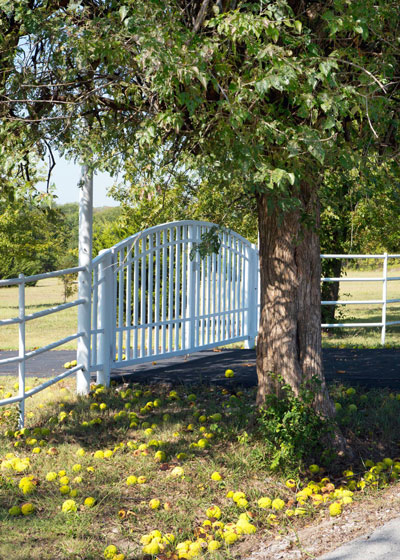
Chester Noecker was my father-in-law. He farmed several hundred beautiful acres 30 miles south of Columbus, Ohio. I never heard him swear. Then again, I was never in the field alongside him when he got slapped in the face by one of bois d’arc’s thorny branches on a cold winter morning. He had nothing kind to say about this tree that’s native over almost all of eastern America.
He called it “hedge.” Others refer to it as “hedge apple,” and others as “Osage orange.” The Osage Indians made bows from its wood, which pretty well explains that French name “bois d’arc,” and that takes us full circle.
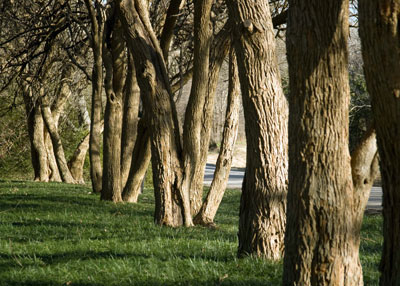
The tree is a venerable old goat that grows along riverbanks, rocky slopes and hillside meadows. Most commonly, you’ll see it growing in old fence rows, sometimes planted on purpose (perhaps the origin of the name “hedge”), and sometimes the result of chance seedlings. The one thing that’s sure: you will see this tree the next time that you drive around town – it’s scattered almost everywhere. And, the other thing that’s almost as certain: you will not see this tree the next time you stop by a local nursery. It doesn’t transplant easily, and they certainly don’t obligate valuable growing space to it.
Did You Know …
A few things I thought you might find interesting:
• Bois d’arc wood is extremely resistant to rotting. That’s why it was used by our great-grandparents as leveling blocks for pier-and-beam houses. You could cut it off into short sections of stout trunk and use them to support an entire house, its belongings and family held safely up off the cold ground. Those old blocks are still out there carrying their loads, 75 and 100 years later.
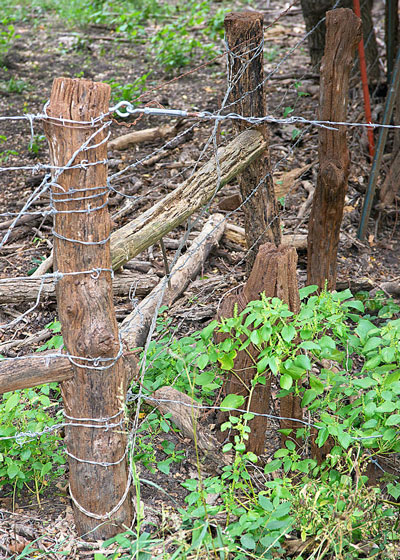
• Bois d’arc was also used by early farmers for fence posts – it wouldn’t rot. The next time you see a gnarly antique rural fence, those crooked old posts are probably bois d’arc. (If they’re straight, they’re probably redcedar.)
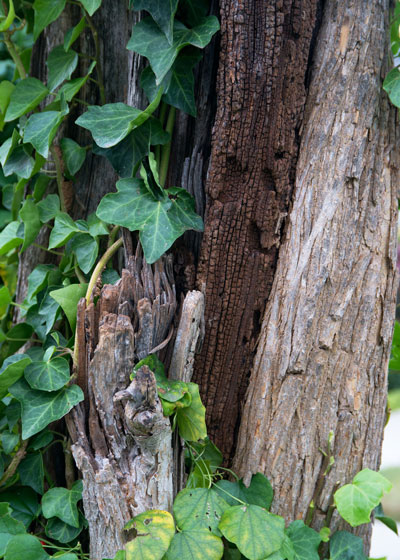
• Bois d’arc wood (as in the timber of the tree) is bright yellow. It browns (oxidizes) as it ages, and that’s why the old blocks and posts will have chocolate-colored, highly fissured surfaces. But, when you cut into their centers, they will still be rich, golden-yellow.
• That old wood is hard. So hard that arborists will cringe and chain saws will dull. So hard that stump-grinders will groan. But, that’s all part of its notoriety.
• Bois d’arc wood is filled with oils that spark when ignited. That’s exciting outdoors in campfires, but it’s not the best plan when you’re sitting on the floor of the den, “singing carols by an open fire.” It’s like bringing real-life sparklers onto your carpet. It burns hot enough that you won’t want to close the glass fireplace doors.
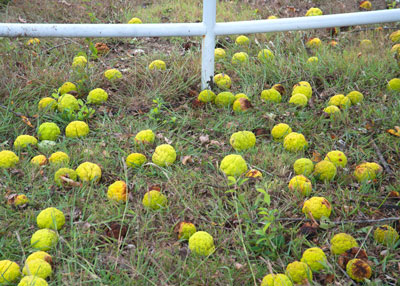
• The large and heavy fruit of bois d’arcs look like green oranges. Then, sometime in mid-fall, they turn yellow and fall to the ground. They’re certainly not edible, at least not by humans. Oh, squirrels will gnaw on them and spit out the shards over the course of the summertime, but polite animals mostly leave them alone. Little boys, by comparison, pick them up to hurl at their buddies (also not a good plan), and that’s when they discover that these harmless-looking fruit are actually big buckets of goo. White, sticky, sappy goo.
Now to my sales pitch…
Bois d’arc (Maclura pomifera) is one of our more dependable Texas natives. Caterpillars will occasionally chew into its leaves, but nothing much kills it. Bois d’arcs do eventually die, but no one’s ever quite sure why. Perhaps it’s the loneliness of being excluded from modern society. Maybe they just get bored.
This large-leafed, coarsely textured tree actually makes an interesting statement in urban landscaping. As with its fellow Texan, the mesquite, bois d’arc brings rugged character to its surroundings. Root flares are exposed by decades of growth and soil erosion. Mistletoe-infested branches become misshapen, even grotesque. And, the tree keeps on living.
Would I ever plant a bois d’arc in my own landscape? Perhaps not. But, would I leave one that was already there when we bought our rural homesite 50 years ago? Yes, and I did.
